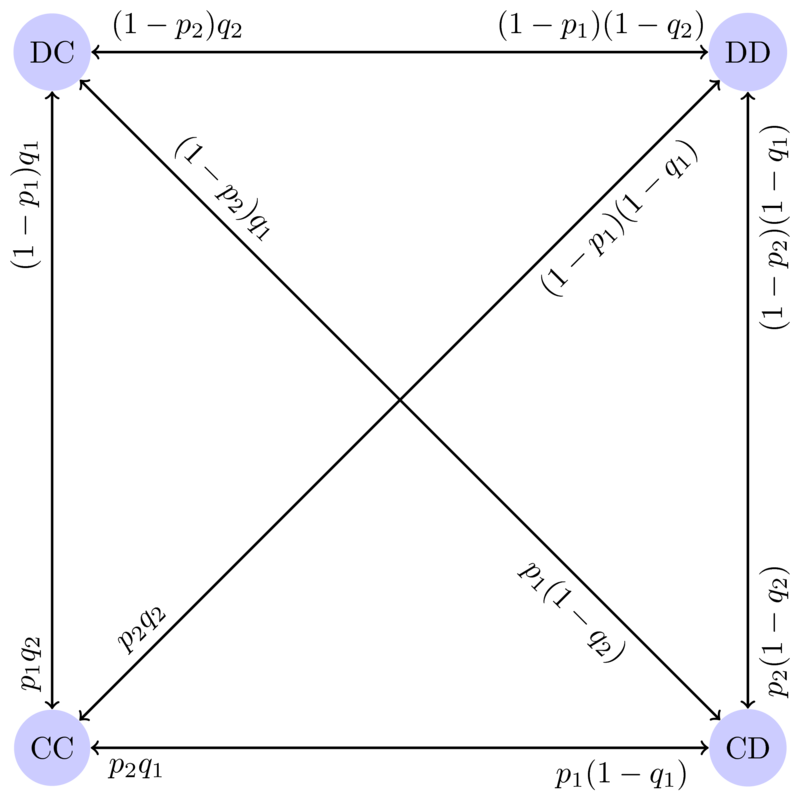07 Prisoners Dilemma¶
Corresponding chapters¶
Objectives¶
- Explore the Iterated Prisoners Dilemma
Notes¶
Playing team based Iterated Prisoner’s Dilemma¶
Show this video: https://www.youtube.com/watch?v=p3Uos2fzIJ0
Ask class to form 4 teams of equal size.
Write the following on the board:
| Name | Score vs 1st opp | \(\sum\) score vs 2nd opp | \(\sum\) score vs 3rd opp |
|---|---|---|---|
Explain that teams will play the iterated Prisoners dilemma:
Discuss NE of stage game.
Discuss “Cooperation” versus “Defection” and explain that goal is to maximise overall score (not necessarily beat direct opponent).
For every dual write the following on the board (assuming 5 turns):
| Name | Score | \(\sum\) score | \(\sum\) score | \(\sum\) score | \(\sum\) score |
|---|---|---|---|---|---|
Instructions for a dual:
- Give both teams copies of a
C and a D. - In your teams: discuss plans for a strategy.
- Before every stage invite both teams to talk to each other.
- Get teams to “face away”, after a count down “show” (either a C or a D).
After the tournament:
- Discuss winning strategy and other interesting strategies. Discuss potential coalitions that arose.
- Discuss how teams had more information that usual.
- Invite the possibility of modifications (prob end, noise and lack of information).
Consider Reactive strategies
Go over theory.

In the case of \((p_1, q_1)=(1 / 4, 4 / 5)\) and \((p_2, q_2)=(2 / 5, 1 / 3)\) we have:
The steady state probabilities are given by:
Here is some sympy code to illustrate this:
>>> import sympy as sym
>>> p_1, p_2 = sym.S(1) / sym.S(4), sym.S(4) / sym.S(5)
>>> q_1, q_2 = sym.S(2) / sym.S(5), sym.S(1) / sym.S(3)
>>> r_1 = p_1 - p_2
>>> r_2 = q_1 - q_2
>>> r_1, r_2
(-11/20, 1/15)
>>> s_1 = (q_2 * r_1 + p_2) / (1 - r_1 * r_2)
>>> s_2 = (p_2 * r_2 + q_2) / (1 - r_1 * r_2)
>>> s_1, s_2
(185/311, 116/311)
>>> pi = sym.Matrix([[s_1 * s_2, s_1 * (1 - s_2), (1 - s_1) * s_2, (1 - s_1) * (1 - s_2)]])
>>> pi
Matrix([[21460/96721, 36075/96721, 14616/96721, 24570/96721]])
We can verify that this is a steady state vector:
Sympy code:
>>> M = sym.Matrix([[p_1*q_1, p_1*(1-q_1), (1-p_1)*q_1, (1-p_1)*(1-q_1)],
... [p_2 * q_1, p_2 * (1-q_1), (1-p_2) * q_1, (1-p_2) * (1-q_1)],
... [p_1 * q_2, p_1 * (1-q_2), (1-p_1) * q_2, (1-p_1) * (1-q_2)],
... [p_2 * q_2, p_2 * (1-q_2), (1-p_2) * q_2, (1-p_2)*(1-q_2)]])
>>> M
Matrix([
[1/10, 3/20, 3/10, 9/20],
[8/25, 12/25, 2/25, 3/25],
[1/12, 1/6, 1/4, 1/2],
[4/15, 8/15, 1/15, 2/15]])
>>> pi * M
Matrix([[21460/96721, 36075/96721, 14616/96721, 24570/96721]])
>>> pi * M == pi
True
The utility is then given by:
Sympy code:
>>> rstp = sym.Matrix([[sym.S(3), sym.S(0), sym.S(5), sym.S(1)]])
>>> score = pi.dot(rstp)
>>> score, float(score)
(162030/96721, 1.675...)